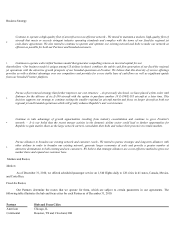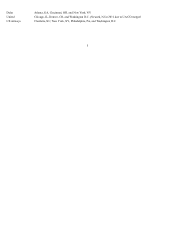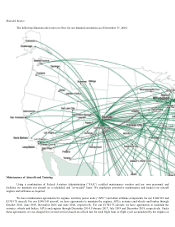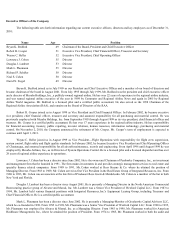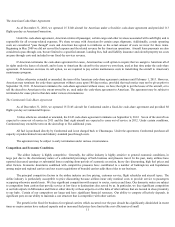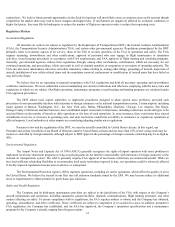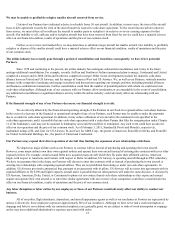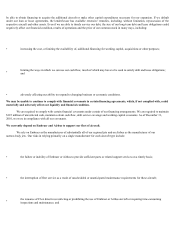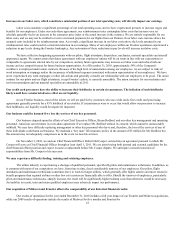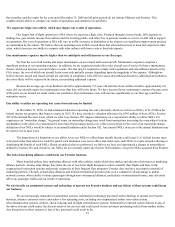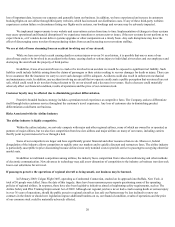Frontier Airlines 2010 Annual Report Download - page 18
Download and view the complete annual report
Please find page 18 of the 2010 Frontier Airlines annual report below. You can navigate through the pages in the report by either clicking on the pages listed below, or by using the keyword search tool below to find specific information within the annual report.regional jets. We believe future growth opportunities in the fixed-fee business will most likely come as contracts come up for renewal though
competition for market share may lead to lower margins and higher risks. If our Partners are negatively affected by economic conditions or
higher fuel prices, they may file for bankruptcy or reduce the number of flights we operate in order to reduce their operating costs.
Regulatory Matters
Government Regulation
All interstate air carriers are subject to regulation by the Department of Transportation (DOT), the Federal Aviation Administration
(FAA), the Transportation Security Administration (TSA), and certain other governmental agencies. Regulations promulgated by the DOT
primarily relate to economic aspects of air service, those of the TSA to security and those of the FAA to operations and safety. The FAA
requires operating, airworthiness and other certifications; approval of personnel who may engage in flight maintenance or operations
activities; record keeping procedures in accordance with FAA requirements; and FAA approval of flight training and retraining programs.
Generally, governmental agencies enforce their regulations through, among other mechanisms, certifications, which are necessary for our
continued operations, and proceedings, which can result in civil or criminal penalties or suspension or revocation of operating authority. The
FAA can also issue maintenance directives and other mandatory orders relating to, among other things, grounding of aircraft, inspection of
aircraft, installation of new safety-related items and the mandatory removal, replacement or modification of aircraft parts that have failed or
may fail in the future.
We believe that we are operating in material compliance with FAA regulations and hold all necessary operating and airworthiness
certificates and licenses. We incur substantial costs in maintaining our current certifications and otherwise complying with the laws, rules and
regulations to which we are subject. Our flight operations, maintenance programs, record keeping and training programs are conducted under
FAA approved procedures.
The DOT allows local airport authorities to implement procedures designed to abate special noise problems, provided such
procedures do not unreasonably interfere with interstate or foreign commerce or the national transportation system. Certain airports, including
major airports at Boston, Washington, D.C., the New York area, Dallas, Philadelphia, Charlotte, Chicago, Los Angeles, San Diego,
Orange County (California) and San Francisco, have established airport restrictions to limit noise, including restrictions on aircraft types to be
used and limits on the number of hourly or daily operations or the time of such operations. In some instances, these restrictions have caused
curtailments in service or increases in operating costs, and such restrictions could limit our ability to commence or expand our operations at
affected airports. Local authorities at other airports are considering adopting similar noise regulations.
Pursuant to law and the regulations of the DOT, we must be actually controlled by United States citizens. In this regard, our
President and at least two-thirds of our Board of Directors must be United States citizens and not more than 25% of our voting stock may be
owned or controlled by foreign nationals, although subject to DOT approval the percentage of foreign economic ownership may be as high as
49%.
Environmental Regulation
The Airport Noise and Capacity Act of 1990 (ANCA) generally recognizes the rights of airport operators with noise problems to
implement local noise abatement programs so long as such programs do not interfere unreasonably with interstate or foreign commerce or the
national air transportation system. The ANCA generally requires FAA approval of local noise restrictions on commercial aircraft. While we
have had sufficient scheduling flexibility to accommodate local noise restrictions imposed to date, our operations could be adversely affected
if locally-imposed regulations become more restrictive or widespread.
The Environmental Protection Agency (EPA) regulates operations, including air carrier operations, which affect the quality of air in
the United States. We believe the aircraft in our fleet meet all emission standards issued by the EPA. We may become subject to additional
taxes or requirements to obtain permits for green house gas emissions.
Safety and Health Regulation
The Company and its third-party maintenance providers are subject to the jurisdiction of the FAA with respect to the Company’ s
aircraft maintenance and operations, including equipment, ground facilities, dispatch, communications, flight training personnel, and other
matters affecting air safety. To ensure compliance with its regulations, the FAA requires airlines to obtain, and the Company has obtained,
operating, airworthiness, and other certificates. These certificates are subject to suspension or revocation for cause. In addition, pursuant to
FAA regulations, the Company has established, and the FAA has approved, the Company’ s operations specifications and a maintenance
program for the Company’ s aircraft, ranging from frequent routine
12


